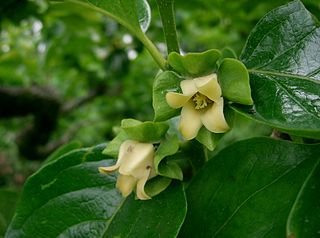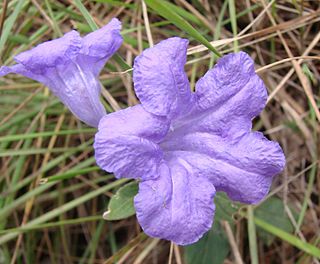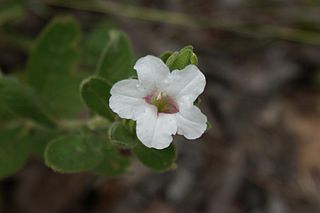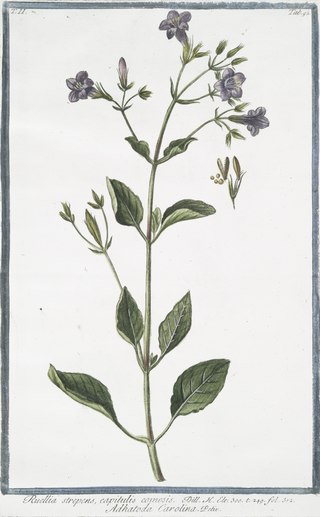
Acanthaceae is a family of dicotyledonous flowering plants containing almost 250 genera and about 2500 species. Most are tropical herbs, shrubs, or twining vines; some are epiphytes. Only a few species are distributed in temperate regions. The four main centres of distribution are Indonesia and Malaysia, Africa, Brazil, and Central America. Representatives of the family can be found in nearly every habitat, including dense or open forests, scrublands, wet fields and valleys, sea coast and marine areas, swamps, and mangrove forests.

Diospyros is a genus of over 700 species of deciduous and evergreen trees and shrubs. The majority are native to the tropics, with only a few species extending into temperate regions. Individual species valued for their hard, heavy, dark timber, are commonly known as ebony trees, while others are valued for their fruit and known as persimmon trees. Some are useful as ornamentals and many are of local ecological importance. Species of this genus are generally dioecious, with separate male and female plants.

Ruellia is a genus of flowering plants commonly known as ruellias or wild petunias. They are not closely related to petunias (Petunia) although both genera belong to the same euasterid clade. The genus was named in honor of Jean Ruelle (1474–1537), herbalist and physician to Francis I of France and translator of several works of Dioscorides.

Ruellia simplex, the Mexican petunia, Mexican bluebell or Britton's wild petunia, is a species of flowering plant in the family Acanthaceae that is native to Mexico, the Caribbean, and South America. It has become a widespread invasive plant in Florida, where it was likely introduced as an ornamental before 1933, as well as in the eastern Mediterranean, South Asia and other parts of the eastern hemisphere.
Ruellia densa is a species of flowering plant in the family Acanthaceae. It is a native to the Cerrado region of central Brazil.

Ruellia humilis is a species of flowering plant in the family Acanthaceae. It is native to the eastern United States. It is grown as an ornamental plant.
Ruellia brevicaulis is a species of flowering plant native to Argentina, Brazil, and Paraguay. It is native to the Cerrado vegetation of Brazil.
Ruellia asperula is a medicinal plant native to eastern Brazil and growing in Caatinga vegetation and Cerrado vegetation. Flowers, leaves, and roots of this plant are usually macerated and used to treat asthma, bronchitis, fever, flu, and uteral inflammation.
Ruellia multifolia is a species of flowering plant in the family Acanthaceae. It is a perennial or subshrub native to west-central, southern, and southeastern Brazil, northeastern Argentina, and Paraguay.

Ruellia geminiflora, known locally as ipecacuanha-da-flor-roxa, is a species native to Argentina; Brazil, typically Caatinga and Cerrado vegetation; Guianas, and Venezuela. The roots of this plant contains possibly toxic substances.
Ruellia menthoides is a species of flowering plant native to northern, eastern, and central Brazil, Bolivia, Peru, and Venezuela. In Brazil it grows in the Cerrado ecoregion. This plant is cited in Flora Brasiliensis by Carl Friedrich Philipp von Martius.
Ruellia dissitifolia is a species of flowering plant in the family Acanthaceae. It is native to the Cerrado ecoregion of Brazil.

Ruellia nitens is a species of flowering plant native to the Cerrado vegetation of central and northeastern Brazil. This plant is cited in Flora Brasiliensis by Carl Friedrich Philipp von Martius.

Ruellia jussieuoides is a species of flowering plant in the family Acanthaceae. It is a subshrub of the tropical Americas, native to central and southern Mexico and Guatemala, Nicaragua, Costa, Rica, and Panama, and Ecuador, Peru, Bolivia, and West-Central and southeastern Brazil. It is native to the Cerrado ecoregion of Brazil.

Ruellia macrantha, or Christmas pride, is a species of flowering plant native to the cerrado vegetation of Brazil. It is often used as an ornamental plant. This plant is cited in Flora Brasiliensis by Carl Friedrich Philipp von Martius.

William Philip Hiern was a British mathematician and botanist.

Ruellia tuberosa, also known as minnieroot, fever root, snapdragon root and sheep potato, is a species of flowering plant in the family Acanthaceae. Its native range is in Central America but it has become naturalized in Africa, South and Southeast Asia.

Ruellia strepens, commonly known as limestone wild petunia, limestone ruellia, smooth wild petunia, or wild petunia is a species of flowering plant in the family Acanthaceae, native to warmer parts of the central and eastern United States. A perennial herb, it prefers to grow in moist to mesic, partly shady areas such as streamsides and bottomland forests. In the garden it is hardy to USDA zone 5, and can tolerate nearly full shade.











